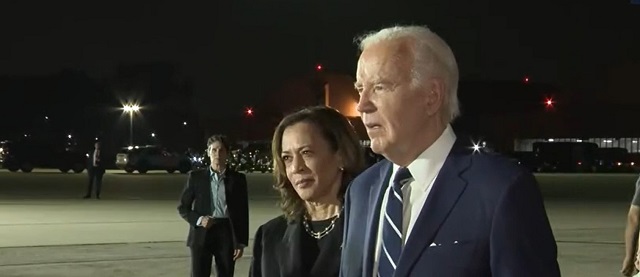conflict
Three Years Later, Biden Still Hasn’t Said Who’s At Fault For Chaotic Afghanistan Withdrawal

 From the Daily Caller News Foundation
From the Daily Caller News Foundation
By Jake Smith
On the third anniversary of the U.S. withdrawal from Afghanistan, the Biden administration has yet to fire any leadership personnel for their role in the botched operation; instead, the administration has maintained that the decision to pull out was the right move.
The U.S. withdrawal from Afghanistan in August 2021 was seen by many as a chaotic and abrupt operation that led to the deaths of several U.S. troops. But the Biden administration has largely refused to admit blame in the matter, and no leadership involved has been dismissed or resigned over the operation, according to a review of multiple records.
The Biden administration’s goal was to withdraw U.S. troops from Afghanistan by September 2021, but a failure of planning and preparation by leadership in Washington created a disordered situation for troops on the ground in Afghanistan, resulting in a disordered evacuation. There was also a miscalculation among military leaders who believed that the Taliban would not seize control of the country as quickly as the extremist group did after U.S. forces withdrew.
The Department of Defense, headed by Secretary Lloyd Austin, was intimately involved prior to and during the withdrawal, guiding U.S. military operations on the ground in Afghanistan and providing resources and intelligence for the operation. Former Joint Chiefs of Staff (JCOS) Chairman retired Gen. Mark Milley — at the time the highest ranking member of the military — was also involved in coordinating strategy and operations for the withdrawal.
Both Austin and Milley attended planning sessions for the withdrawal, retired Gen. Austin Scott Miller, the top U.S. general in Afghanistan at the time, told lawmakers during a closed-door hearing in April, according to The Washington Post. Miller had been privately warning the administration ahead of the withdrawal that Afghanistan’s stability would get “very bad, very fast” after U.S. forces departed.
Miller stepped down from his role in July 2023, after serving as the most senior U.S. officer in Afghanistan. Neither Austin nor Milley were removed from their roles over the withdrawal, though Milley testified in 2023 that he had advised the administration to keep troops in Afghanistan, arguing that the region would quickly collapse if the U.S. withdrew on the set timeline, according to The New York Times. Milley’s term as JCOS chair ended in September 2023.
For his part, Austin testified in 2023 that he supported Biden’s decision to evacuate U.S. troops in 2021 and said he didn’t “have any regrets” about the operation. Austin remains the current Secretary of Defense under Biden.
Similar to the Department of Defense, the State Department, led by Secretary Antony Blinken and tasked with overseeing U.S. foreign affairs, was also involved in planning and helping execute the Afghanistan withdrawal, especially regarding evacuating U.S. citizens present in the country. Thousands of Americans were initially stranded in Afghanistan; most of them were evacuated in the weeks and months following.
A State Department 2023 after-action report found that the withdrawal operation “was hindered by the fact that it was unclear who in the Department had the lead.” The report also noted that there was an “insufficient senior-level consideration of worst-case scenarios.”
There have been multiple credible reports that the State Department on various occasions failed to properly vet or track millions in aid to Afghanistan following the U.S. withdrawal in 2021, running the risk it could end up in the hands of the Taliban or other extremist groups.
The U.S. left over $7 billion worth of military equipment in Afghanistan. The Taliban, an Islamic extremist group ruling over Afghanistan, held a demonstration on Wednesday with American military equipment and vehicles left at a former U.S. base in the country.
Biden has not dismissed Blinken, and Blinken has not resigned from his role as Secretary of State. Nor has Jake Sullivan, Biden’s national security adviser, who would have had his ear and offered him advice prior to and during the withdrawal.
A Biden administration 2023 report assigned most blame on the former Trump administration for the withdrawal, given that Trump signed an agreement with the Taliban in 2020 to withdraw U.S. forces by 2021. After taking office in 2021, Biden tried to abide by the agreement and withdraw forces by September of that year, according to the report.
Trump and his team argue that had he been president at the time, the withdrawal would have been executed in a safe and secure manner, and blamed the Biden administration for “trying to gaslight the American people for their disastrous withdrawal from Afghanistan that directly led to American deaths and emboldened the terrorists.”
Biden has defended his choice to withdraw U.S. forces from Afghanistan when he did. He falsely claimed during a debate against Trump in June that he was “the only president this decade that doesn’t have any troops dying anywhere in the world.”
Following the withdrawal, Biden also reportedly told his top aides, including Sullivan, that he supported them and their decisions regarding the operation, according to Axios.
The Pentagon and State Department did not immediately respond to the Daily Caller News Foundation’s request for comment.
Artificial Intelligence
AI Drone ‘Swarms’ Unleashed On Ukraine Battlefields, Marking New Era Of Warfare


From the Daily Caller News Foundation
Artificial intelligence-powered drones are making their first appearances on the battlefield in the Russia-Ukraine war as warfare creeps closer to full automation.
In bombardments on Russian targets in the past year, Ukrainian drones acting in concert were able to independently determine where to strike without human input.
It’s the first battlefield use of AI “swarm” technology in a real-world environment, a senior Ukrainian official and Swarmer, the company who makes the software, told the Wall Street Journal in a Tuesday report. While drones have increasingly defined modern battlefields, swarms until now had been confined to testing rather than combat.
“You set the target and the drones do the rest,” Swarmer Chief Executive Serhii Kupriienko told the WSJ. “They work together, they adapt.”
So far, the Swarmer technology has been used hundreds of times to target Russia assets, but was first used a year ago to lay mines on the front, the Ukrainian official told the WSJ. The software has been tested with up to 25 drones at once, but is usually utilized with only three.
Kupriienko told the WSJ that he was preparing to test up to 100 drones at once with the linking software.
A common arrangement used on the battlefield includes one reconnaissance drone to scout out the target and two explosive drones delivering the payload on target, the official told the WSJ.
While Western nations such as the U.S., France and the United Kingdom are also pursuing drone swarm technology, they have not deployed swarm technology on the battlefield the way Ukraine has, according to the WSJ. Currently, autonomous weapons are not regulated by any international authority or binding agreement, but ethical concerns around the technology has led many to call for increased regulation of weapons like the Swarmer system.
The Ukrainian Ministry of Foreign Affairs did not immediately respond to the Daily Caller News Foundation’s request for comment.
conflict
Trump Pentagon Reportedly Blocking Ukraine From Firing Western Missiles Deep Into Russia


From the Daily Caller News Foundation
The Department of Defense has spent months blocking the Ukrainian military from using American and British-made missiles to hit targets deep inside Russia, The Wall Street Journal reported Sunday, citing unnamed U.S. officials.
Undersecretary of Defense for Policy Eldridge Colby reportedly designed the procedure to review requests to carry out the long-range strikes with weapons that are either of U.S. origin or that require American intelligence or use components provided by the U.S., according to the WSJ. Secretary of Defense Pete Hegseth reportedly has the final say on whether Ukrainian forces can use the MGM-140 ATACMS (Army Tactical Missile System) to hit targets in Russia.
The reported blocks on missile strikes coincides with a Trump administration effort to broker a peace deal between Russia and Ukraine. A Pentagon spokesperson declined to comment further on the matter.
BREAKING: President Vladimir Putin reacts to B-2 Flyover pic.twitter.com/1mzVn7DxlW
— Jack Poso 🇺🇸 (@JackPosobiec) August 15, 2025
The Biden administration allowed Ukraine to carry out strikes with ATACMS in November, weeks after President Donald Trump won the 2024 election, the New York Times reported. Trump criticized the move during a December interview with Time magazine.
“It’s crazy what’s taking place. It’s crazy,” Trump said. “I disagree very vehemently with sending missiles hundreds of miles into Russia. Why are we doing that? We’re just escalating this war and making it worse. That should not have been allowed to be done.”
Trump and Russian President Vladimir Putin met in Alaska on Aug. 15 for a summit meeting during which Trump sought to secure a cease-fire in Russia’s war with Ukraine. As Trump greeted Putin, a B-2A Spirit stealth bomber and several fighters carried out a flyover of Elmendorf Air Force Base.
Trump met with Ukrainian President Volodymyr Zelensky and major European leaders on Aug. 18 to update them on the summit.
In July, Trump reached an agreement with NATO where members of the alliance would purchase weapons, including MIM-104 Patriot surface-to-air missiles, and donate them to Ukraine.
-

 Business20 hours ago
Business20 hours agoTrans Mountain executive says it’s time to fix the system, expand access, and think like a nation builder
-

 Alberta2 days ago
Alberta2 days agoCoutts border officers seize 77 KG of cocaine in commercial truck entering Canada – Street value of $7 Million
-

 Alberta1 day ago
Alberta1 day agoPremier Smith sending teachers back to school and setting up classroom complexity task force
-

 Business2 days ago
Business2 days agoThe painful return of food inflation exposes Canada’s trade failures
-

 Alberta1 day ago
Alberta1 day agoThousands of Albertans march to demand independence from Canada
-

 Crime1 day ago
Crime1 day agoSuspect caught trying to flee France after $100 million Louvre jewel robbery
-

 Addictions22 hours ago
Addictions22 hours agoThe Shaky Science Behind Harm Reduction and Pediatric Gender Medicine
-

 Business2 days ago
Business2 days agoCBC uses tax dollars to hire more bureaucrats, fewer journalists








